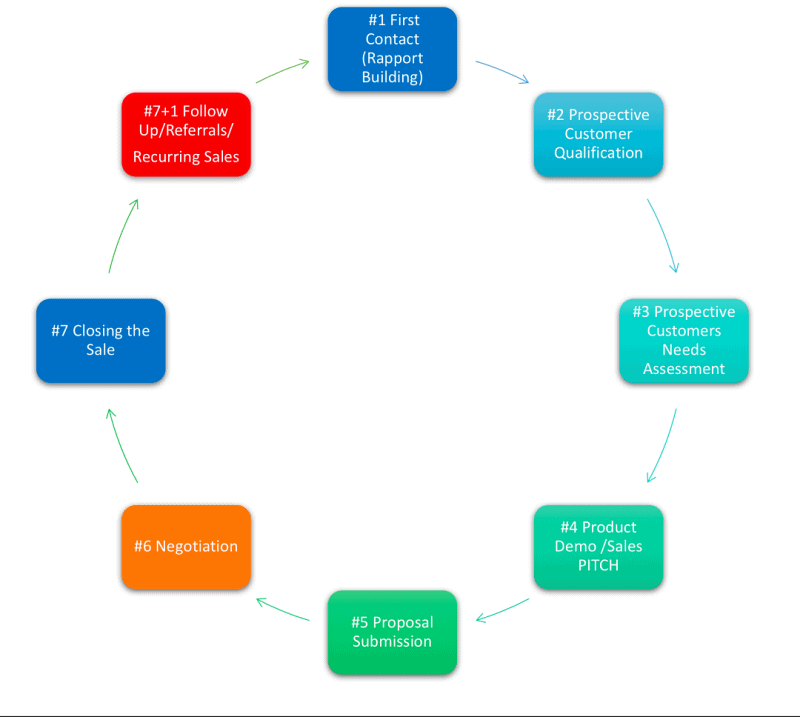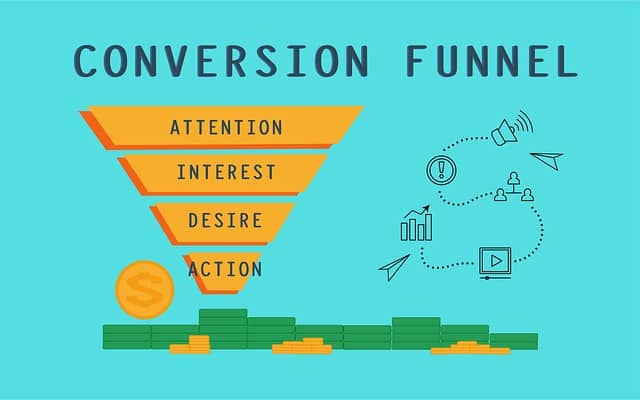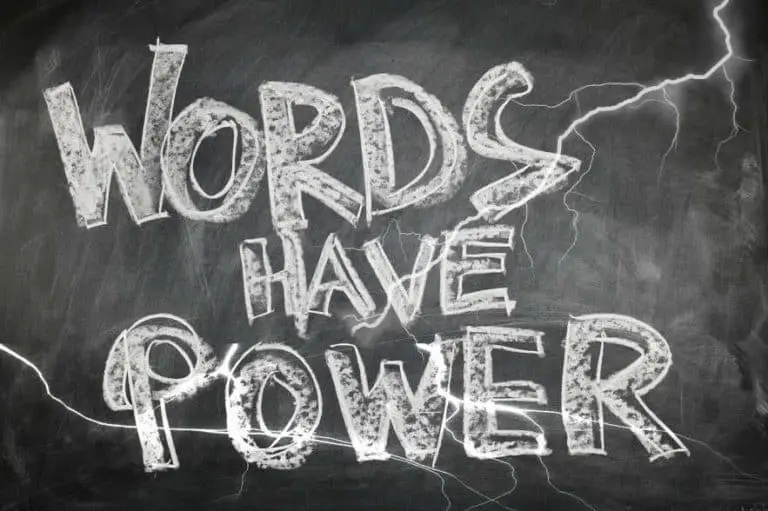7+1 Sales Process Steps To Close Deal Every Time
In every organization, sales, if not rave sales, are the lifelines that keep every other thing going on smoothly. Without sales, the liquidation of such an organization is inevitable.
While sales are very important for an organization’s continued existence, a functional sales process for the sales team to follow and work with is also as important as sales itself. With this, you can tell that your sales team will have little or zero challenges in converting potential clients from just visitors or leads to loyal and paying clients.
A functional sales process serves as the roadmap in which your sales team needs to decide the next line of action in converting prospects to loyal customers.
So, in this article, you will be learning the 7+1 sales process steps that your sales team needs to close deals every time.
What Is A Sales Process?
A sales process is a set of laid down guidelines, which are carefully designed to help the sales team to convert prospective customers into paying and loyal customers effectively.
Depending on your products and services and who your target customers are, the sales process can span from 3 to 7 or even 10 steps.
Every sales process that is designed to work as expected is usually designed to mirror the exact process or journey in which your customers go through before they commit to buying or patronizing your products and services.
Why Is A Sales Process Important?
A standard sales process is important for any organization due to its ability to increase the conversion rate. And this is achieved through a deliberate breakdown of the entire sales strategy into steps that are very easy to implement by the sales team.
For most businesses that witness their untimely exit, implementing a sales strategy without a well-defined sales process is the major mistake that leads to such a sad ending.
Sadly, most organizations think that a functional client acquisition strategy is enough. As a result of this, they leave the selling and closing process to the sales team’s mercy and discretion, which usually leads to a lot of business inconsistency.
For instance, if a new prospect contacts your organization through the referral of a loyal customer, and the services or products they receive is quite different from what they expected, that may lead to the loss of potential and prospective customers from such client.
And in most cases, the customer’s disappointment may even lead to negative feedback and review on your various online platforms.
But on the contrary, with a standardized sales process where the various stages of converting leads to paying customers are maintained, prospective customers will always enjoy the same products and service delivery from all sales team members.
With this, you are sure of consistency in customer satisfaction and lead conversion, irrespective of which sales rep that is present at a given point in time.
This can also lead to increased customer retention, improved close rates, and more sales, which is the ultimate goal of your business.
Sales and Pitching Related Posts:
13 Ways to Effectively Deliver a Business Pitch Presentation
7 Basic Elements of Sales Presentations
What Are The Sales Process Steps To Close A Deal Every Time?
Step #1: Make initial contact and establish a friendly rapport
Step #2: Qualify the compatibility of prospective leads
Step #3: Conduct needs assessment for prospective leads
Step #4: Product Demo/Sales Pitch
Step #5: Proposal submission and mutual handling of objections
Step #6: Negotiation
Step #7: Closing
Step 7+1: Follow up – Recurring transactions and referrals

Step #1: Make initial contact and establish a friendly rapport
For every sales process, the very first step starts from leads generation.
Lead generation may be through networking, from the marketing team, then transferred to the sales team, cold calling, or customer referral.
Right after lead generation, the next in line is leads qualification to select those leads you are sure may need your products and services. Once this is done, making initial contact with qualified leads follows immediately.
It is important to note that finding one prospect from an organization isn’t enough in a modern sales funnel.
So, in such a situation, connecting with as many decision-makers as possible on the purchasing end (multi-threading) is the best way to validate that your prospect is a potential paying customer.
Other things to look out for or ask when making the first contact with your prospect include;
- Who is going to be responsible for making purchase decisions on your product and services – this means talking directly with the decision-maker.
- Know how your prospect got to know about your business, products, and services.
- What is the most convenient number or means of communication to reach your prospect?
With these, you are sure that the first step in your sales process has been taken care of without leaving any stone unturned.
Step #2: Qualify the compatibility of prospective leads
At this point, the next thing to be done on your sales process is a thorough and unbiased evaluation of your prospective lead compatibility with your products and services.
In doing this, you carefully put everything into consideration to see if there is any likelihood of your prospect becoming a loyal or paying customer. With this, your sales team is trying to see whether or not the prospective lead will turn out to be a sales qualified lead or not.
They can ascertain this by checking to see if your organization’s products and services are in line with the prospective leads’ needs.
To achieve this effectively, there is a need to qualify various things such as product needs, timeline, budget, and any other criteria about the prospect.
In carrying out a complete compatibility analysis of a prospective lead, here are some questions your sales team may ask to tell whether or not there is headway with a prospect;
- What are the key considerations of our prospect?
- What are the expectations of our leaders if they should buy our products and services?
- How do our products and services fit into our prospect’s business?
- Are there other things we should consider in our products and services to ensure that they align with our prospects’ business processes? (B2B sales)
If, after giving correct answers to all these questions and there are still some incompatibilities between your products and services and a prospective lead, it becomes evident that it is time to move on to another lead that could be a better match.
Step #3: Conduct needs assessment for prospective leads
If your prospective leads were found qualified for your products and services, the next thing in line for your sales team to do is to map out some standard questions, they will ask prospective leads.
Doing this will guide your sales teams in making inquiries about the most important details as well as having a road map for their conversation with the prospect.
Also vital about mapping out questions for prospects is that doing so will create an impression of professionalism to the prospects.
However, when writing out questions that will aid in a proper needs assessment of prospective leads, such questions should be open-ended to create the opportunity for a two-way discussion between the sales team and the prospects.
Also very important at this stage of the sales process is the sales team’s ability to listen more instead of doing much of the talking – they should be more interested than being interesting. Although your sales team may be tempted, they shouldn’t start talking about their products and services.
The ultimate aim of this stage is to better understand the prospect’s condition, constraints, and motivating factors that will encourage them to purchase the products and services you are bringing to the table. With this, your sales team will be able to shape their sales demo and pitch to each prospect’s specific and unique needs.
Some typical questions that may be asked by your sales team at this stage include;
- What are the desirable and undesirable traits you observed in your former provider?
- What are your business’s specific problems that you look forward to having us solve through our products and services?
- Kindly share a bit about your current condition.
After an extensive discussion of all these questions between your sales team and the prospects, it is expected that your team confirms their understanding of everything they heard from the prospect.
In doing this, the best way is for your sales rep to recap everything the prospect has told them and requesting an affirmation from the prospect.
Once this is done, your sales team certainly shares the same thoughts as the prospects before moving on to the next stage in the sales process. However, if there was any misinterpretation of any answer from the prospect, your sales team may ask further questions to ensure that they are on the same page with the prospect.
Step #4: Product Demo/Sales Pitch
After a careful examination and understanding of the prospect’s needs, it is then time for your sales team to clearly explain the value of your products and services to the prospect. When doing this, it is important to make it about the prospect’s needs, constraints, and motivation.
To achieve this efficiently, your sales team needs to connect the prospect’s needs to the features and advantages of the products and services they are offering the prospect. For this reason, your sales rep must have a clear understanding of everything that has been discussed at the needs assessment step of the sales process.
And while carrying out the product demo and sales pitch, it is also important for the sales team to take note of those specific areas of benefits about your products and services in which the prospect seems very excited about.
Finally, this step may be concluded with an agreed date when both parties will meet to deliberate the business proposal (if applicable for your products and services).
Step #5: Proposal submission and mutual handling of objections
As mentioned earlier, there are some products and services that don’t always require a business proposal. So, if your products and services are one that demands that your sales team submit a proposal to their prospects, such must be tailored in line with the needs, constraints and motivation of the prospects.
And while present their proposal, your sales team may have to focus more on the value potentials of their products and services as well as how it will help their potential customer to meet their desired goals. After the presentation of the proposal from your sales rep (if there was one), it is expected that the prospect will express their concerns and questions – often referred to as objections.
However, in most cases, there are usually some recurring objections from prospects. For this reason, your sales team must keep a record of such concerns and objections so that they can leverage on that to give the best response possible whenever such objections are raised by a potential customer.
With this, you can tell that your sales team will appear professional and will always be prepared for any objection that may want to hinder them from closing sales with a potential client.
Brian Tracy is a master when it comes to teaching businesses and professionals on how to handle objections during a Sales process. Note that overcoming objections is a key step to closing any sale. Check below some pearls of wisdom shared by Brian Tracy on the topic.
Step #6: Negotiation
Based on the objections and concerns raised by a prospect during the proposal submission stage, there might be a need to amend the proposal to suit your prospect’s needs, constraints, or any other objections.
Once the proposal has been amended, negotiation can only commence once there is a full understanding of all the terms of your offer by your prospective client.
To have a soft landing in the negotiation process, your sales team should be able to point out what can be referred to as high value for the client and a reasonably low cost for themselves to close the deal successfully.
In doing this, conditions such as a longer payment plan for the client or better and quicker service delivery can be some useful considerations to help close the deal.
And to solidify your claims during the negotiation, your sales team has to reiterate the specific benefits and advantages of your products and services that will help the client meet their particular needs.
Step #7: Closing
Here comes the long-awaited step in the whole sales process. At this point, the prospect may choose to either commit by making a purchase or back out on the entire process.
Well, this point may seem like the most important step in the whole sales process. Yes, the whole process will yield the expected result from your sales team only if the preliminary stages in the cycle were handled and completed professionally and in the best manner.
At this stage, all objections to your proposal must have been properly addressed, and every other detail regarding product and service delivery concluded.
And as your sales team makes the sale, it is assumed that the prospective client has consented to the terms and the price offered by your sales team or negotiated for a mutually beneficial price to both parties.
While the deal is set to be closed, this final stage may also involve introducing other members of your organization to the client. These members may be responsible for handling other steps involving product and service delivery to the client.
Step 7+1: Follow up – Recurring transactions and referrals
After the first purchase from your client, it is expected that they have a personal evaluation of their business experience with your organization.
If they found your company to be true to the world of promises made by your sales team, you can then raise a glass and toast to a successful deal since your client is most likely to call on you for subsequent business needs.
With such a high level of satisfaction from your products and services, your client will also be receptive to invest in other products and services from your business.
A big plus to your organization is the fact that your client will serve and act as a source of referrals for your products and services.
Besides all of these, you still have some responsibility to fulfill to ensure that the business line stays open. This, you can do through some form of marketing communications involving sharing industry news, organizing some form of the interactive reward program, e-newsletter, or even through regular updates about new products and services.
With this, your customer will always consider your organization the first choice whenever they or a friend needs your products and services.
One interesting thing in this steps is really getting the customer to be your CHAMPION. Clarity Business Growth’s video on the Simple and Proven 8 Step Sales Process, addresses this concept quite nicely. Check it out below!
Wrap Up
Here you have it all – the top 7+1 steps sales process to close the deal every time. Although some products and services may require a shorter sale process, this is the most conventional process your sales process should go to ensure that every contact and lead is converted to a paying customer.
Need more tips on how to scale up your business? Check back soonest for our next series shortly.
REFERENCES & FURTHER READING
Zarema Plaksij. Sales Process: A roadmap for better Sales Performance
Hubspot The 8 Steps of the Sales Process: What do You Need to Know
LucidChart. 7-Step Sales Process: When to use it when to break it
Act365. The 7 Steps Sales Process
https://www.acethepresentation.com/elements-of-sales-presentations/







